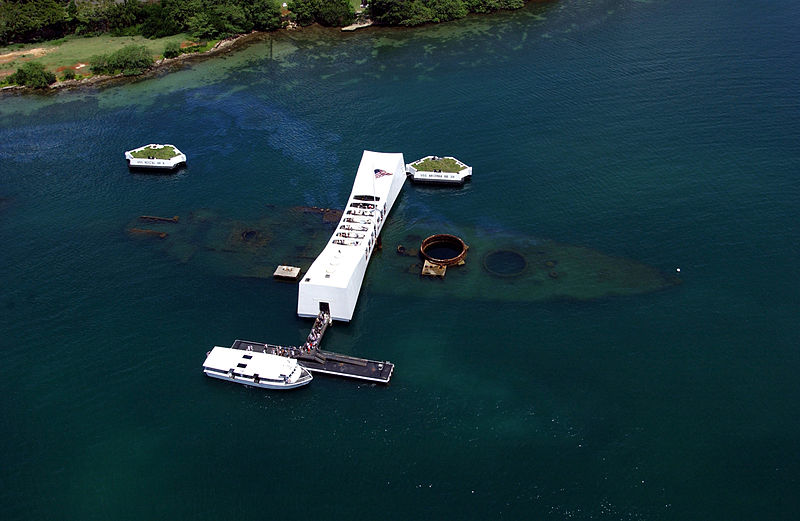
Aerial view of USS Arizona Memorial at Pearl Harbor shows the sunken ship, and oil seepage from its bunkers. In the foreground, visitors disembark from a U.S. Navy tour boat.
MORE THAN SEVEN DECADES FROM DEC. 7, 1941
MEMORIAL SITE AFFECTS VISITORS INTENSELY
Oil still seeps from sunken USS Arizona’s bunkers
By David Maril
Looking through several metropolitan daily newspapers Saturday, on the anniversary date that President Franklin Roosevelt declared would be a day that would live “in infamy,” there was hardly a mention of Pearl Harbor.
There were no significant references in the New York Times or Washington Post to the 72nd anniversary of the attack, which launched the United States into World War II.
The Baltimore Sun did, however, have, on an inside page, a Reuters wire story about a 92-year-old former pilot who remembers the sound of the Japanese aerial attack.
But this doesn’t mean Pearl Harbor is being forgotten. Despite heavy criticism — much of it justified — that our culture has become too obsessed with hype, marketing and living for the moment, we do maintain a reflective side and allow some focus on analyzing what major events from our history mean.
Maybe we are not learning enough from history to not be doomed to repeat all of it. Lately, however, our nation seems to be in a contemplative mood. We recently journeyed through more than a week of reliving the assassination of President John F. Kennedy on the 50th anniversary of that tragedy.
This week we are reliving the inspirational legacy of Nelson Mandela, who survived 27 years of imprisonment as an anti-apartheid revolutionary to become president of South Africa from 1994 to 1999. The former Nobel Peace Prize recipient died on Dec. 5 at age 95.
Because Mandela’s death occurred only days ago and is fresh in people’s minds, coverage of his life’s story dominates the news.
NO LONGER FRONT PAGE NEWS, BUT NOT FORGOTTEN
But just because the Pearl Harbor attack isn’t front page news doesn’t mean that it is being forgotten.
A visit to the Pearl Harbor Memorial, which opened in 1962, remains an unforgettable experience.
On a vacation trip a few years ago to Hawaii, I was caught by surprise at the way the memorial site affects people. It’s a very heavy emotional experience to ride in a boat and observe hundreds of loud, jovial, carefree tourists on a Hawaiian vacation suddenly be overcome with sadness when they reach the resting place of the USS Arizona.
Pearl Harbor remains a stark study in contrasts, and a reminder that threats of war and terrorism can lurk even in the safest and most peaceful-looking of settings.
In the background is Honolulu’s pleasant, sunny and tropical-paradise harbor. The white beach sand sparkles, and the clear, turquoise water looks pristine enough to drink. The island is one big vacation celebration, with thousands of visitors soaking up too much sun and attending too many luaus, trying to temporarily escape the realities of their everyday existence back home.
MANY VISIT MEMORIAL AS AFTERTHOUGHT
Many tourists visit Pearl Harbor as an afterthought, figuring it‘s a nice and inexpensive change of pace from the beach scene for part of a day. The Pearl Harbor Memorial, located at the Navy base, is free of charge, and there are no reservations required.
Nothing seems out of the ordinary when a tourist first arrives. A visitors’ center with a movie theater provides relief from the hot tropical sun. It’s after the film projector starts to roll, beaming grainy black-and-white scenes of bombings in the harbor, that the horror of the surprise 1941 attack begins to sink in.
The grim facts in the 20-minute film are appalling. You learn the attack by 353 Japanese bombers claimed more than 2,300 American lives and that over 1,100 people were wounded. Twelve military ships were sunk or beached and nine others damaged. Japanese bombers destroyed 164 American airplanes and damaged 159 more.
After the movie, visitors board a Navy boat that motors out to the white flotilla memorial in the harbor.
The chatter on the launch becomes more subdued as the boat nears the flotilla.
MOVIE IMAGES OF DEVASTATION
As the boat’s passengers, made up of people of all ages, gaze out across this peaceful-looking harbor, thoughts keep returning to those movie images of devastation. It makes you wonder if it was a similarly beautiful day when the Japanese bombers arrived. What a shock it must have been for everyone within miles of this safe-looking harbor as they were waking up.
After boarding the floating memorial, all that’s heard is the lapping of the waves hitting the sides of the structures. Most of the visitors keep looking down, staring through the watery shadows to see the top of the USS Arizona, which still holds the bodies of more than 1,100 crewmen who perished on that fateful day. Patches of oil still float to the surface from the sunken ship’s bunkers.
Many of the tourists drop flowers into the water, honoring the dead. They also visit a shrine room containing the names engraved on a marble wall of all those who died on the ship.
The silence continues on the return ride back in the Navy shuttle boat. People seem to voluntarily keep their cellphones in the off-mode.
For many of these travelers, the details of the Pearl Harbor visit is what will always stay sharpest in their minds from their getaway vacation trip to Honolulu.
davidmaril@hermanmaril.com
“Inside Pitch” is a weekly opinion column written for Voice of Baltimore by David Maril.
EDITOR’S NOTE:
The battleship Arizona was hit during the first wave of the Dec. 7, 1941 Japanese surprise attack on Pearl Harbor and sank in just nine minutes, killing 1,177 crewmen, including her captain and the commander of Battleship Division One. In just two hours, more than 20 ships were sunk or damaged and 164 U.S. planes destroyed.
More than 2,300 Americans were killed in the attack, including 48-68 civilians. A total of 1,139 were wounded. Japanese casualties were light, just 65 killed or wounded and one sailor captured.
The Arizona was a Pennsylvania-class battleship built in 1914 and launched a year later. She was commissioned in 1916, modernized in 1931. Rear Adm. Isaac C. Kidd, the commander of Battleship Division One, was on board during the Japanese attack and was the first flag officer killed in the Pacific war.
The fact that negotiations between the United States and Japan were ongoing at the time, and that the two nations were at least officially at peace, led President Franklin D. Roosevelt to proclaim “December 7th, 1941, a date which will live in infamy.”
CHECK OUT LAST WEEK’S “INSIDE PITCH” COLUMN: click here
…and read previous Dave Maril columns by clicking here.






December 11th, 2013 - 1:11 PM
Editor, thanks for the history lesson.
December 15th, 2013 - 6:38 PM
[…] OUT LAST WEEK’S “INSIDE PITCH” COLUMN: click here …and read previous Dave Maril columns by clicking here. Filed under: Top Stories […]